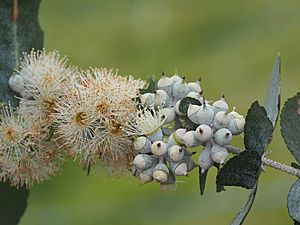Buxton gum facts for kids
Quick facts for kids Buxton gum |
|
|---|---|
 |
|
| Leaves, buds and flowers of Eucalyptus crenulata | |
| Conservation status | |
| Scientific classification | |
| Genus: |
Eucalyptus
|
| Species: |
crenulata
|
Eucalyptus crenulata, often called Buxton gum, silver gum, or Victorian silver gum, is a special kind of tree. It's a medium-sized tree that is quite rare in the wild. You can only find it naturally growing in a small part of Victoria, Australia. However, many people plant it in gardens and parks because it's so beautiful.
This tree has rough bark on its trunk. Its leaves are shaped like eggs or hearts and grow in pairs. The flower buds are covered in a white, powdery coating, and the flowers themselves are white. After flowering, it grows cup-shaped fruits.
Contents
What Does Buxton Gum Look Like?
Eucalyptus crenulata is a tree that usually grows to be about 10 to 12 meters (33-39 feet) tall. It has a special woody swelling at its base called a lignotuber. This helps the tree regrow if it gets damaged, like from a bushfire.
The bark on the main trunk is hard and rough, usually grey, brown, or black. The bark on its branches is smooth and can be grey or yellowish.
Leaves and Flowers
Young Buxton gum trees have egg-shaped or heart-shaped leaves that grow in opposite pairs. These leaves are paler on the underside and don't have a stalk (they are sessile). They are about 20-65 mm (0.8-2.6 inches) long and 15-55 mm (0.6-2.2 inches) wide.
As the tree gets older, its leaves look similar to the young ones. However, the young leaves are covered with a white, powdery layer that eventually wears off. A cool fact about these leaves is that their edges have small, rounded teeth, like tiny scallops!
The tree's flower buds grow in groups of seven, nine, or eleven. They are found where the leaves meet the stem (called a leaf axil). Each group of buds sits on a small stalk called a peduncle, which is about 1-8 mm (0.04-0.3 inches) long. Each individual bud also has its own tiny stalk, a pedicel, about 1-4 mm (0.04-0.16 inches) long.
When the buds are ready, they are oval or almost round and covered in a powdery white coating. They are about 5-7 mm (0.2-0.3 inches) long and 3-4 mm (0.1-0.2 inches) wide. Each bud has a beak-shaped cap called an operculum that falls off when the flower opens.
Buxton gum trees usually flower from September to February, and their flowers are white. After the flowers, the tree produces a woody, cup-shaped fruit. This fruit is a type of capsule (a dry fruit that opens to release seeds). It's about 3-5 mm (0.1-0.2 inches) long and 4-6 mm (0.2-0.24 inches) wide, sitting on a pedicel up to 3 mm (0.1 inches) long. The parts that release the seeds are tucked inside the rim of the fruit.
How Buxton Gum Got Its Name
The scientific name for this tree, Eucalyptus crenulata, was first officially described in 1939. This was done by two scientists, William Blakely and Wilfred de Beuzeville. They studied a sample of the tree found near a place called Buxton in Australia.
The second part of its scientific name, crenulata, is a Latin word. It means "having small, rounded teeth." This name was chosen because of the tiny, scalloped teeth found along the edges of the tree's leaves.
Where Does Buxton Gum Grow?
Buxton gum trees naturally grow in wet, swampy areas at the bottom of the Great Dividing Range mountains.
Today, we only know of two places where this tree grows naturally in the wild. One is near the Acheron River valley, close to Buxton. The other is on the Yarra River floodplain in a place called Yering. Both these locations are in Victoria, Australia.
Even though it's rare in the wild, many more Buxton gum trees are grown by people in gardens, parks, and other planted areas.
Protecting Buxton Gum
Because Eucalyptus crenulata is so rare in its natural environment, it is considered an "endangered" species. This means it's at high risk of disappearing forever.
The Australian Government lists it as "endangered" under a law called the Environment Protection and Biodiversity Conservation Act 1999. The state of Victoria also lists it as "threatened" under its own law, the Flora and Fauna Guarantee Act 1988. These laws help protect the tree and its natural habitats.
See also
 In Spanish: Eucalyptus crenulata para niños
In Spanish: Eucalyptus crenulata para niños





